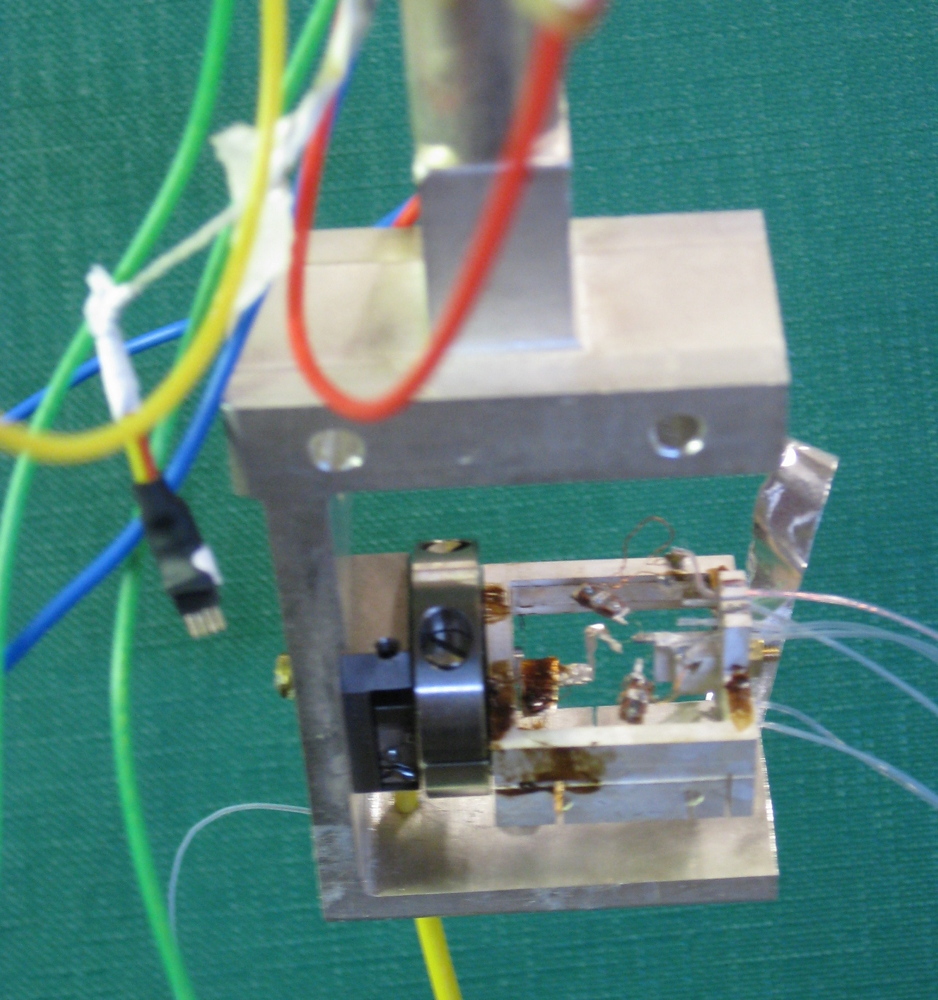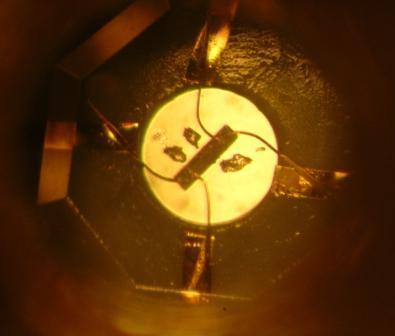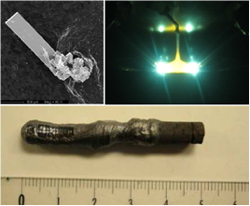 Measurements in a wide temperature (0.005 K - 300 K) and magnetic field range (0 - 18 T) and pressure range (0 - 20 GPa) can be performed in the laboratory:
Measurements in a wide temperature (0.005 K - 300 K) and magnetic field range (0 - 18 T) and pressure range (0 - 20 GPa) can be performed in the laboratory:
 Set up for thermal conductivity and thermal transport measurements on a rotating sample holder.
Set up for thermal conductivity and thermal transport measurements on a rotating sample holder.
 • several dilution refrigerators for standard measurements cryomagnets up to 18 T can be used with different cryostats
• several dilution refrigerators for standard measurements cryomagnets up to 18 T can be used with different cryostats
 • 15 T magnet for measurements down to 0.005 K
• 15 T magnet for measurements down to 0.005 K
 •
3He cryostat,
4He cryostats
•
3He cryostat,
4He cryostats
 • very low temperature thermal transport measurements (T > 0.005 K) thermoelectric power
• very low temperature thermal transport measurements (T > 0.005 K) thermoelectric power
 • measurements specific heat to very low temperatures
• measurements specific heat to very low temperatures
 • possibility of continuous sample rotation in dilution
• possibility of continuous sample rotation in dilution
 • quantum oscillations measurements
• quantum oscillations measurements
 • fast sample characterisation can be performed in an PPMS from Quantum design with 9 T magnet and
3He option
• fast sample characterisation can be performed in an PPMS from Quantum design with 9 T magnet and
3He option
 High pressure experiments:
High pressure experiments:
 Sample with four contacts for resistivity measurements in diamond anvil cell.
Sample with four contacts for resistivity measurements in diamond anvil cell.
 • piston cylinder pressure cells for transport, susceptibility, thermal expansion, and neutron scattering experiments
• piston cylinder pressure cells for transport, susceptibility, thermal expansion, and neutron scattering experiments
 (0 - 3 GPa, 25 mK - 300 K, 0 - 18T)
(0 - 3 GPa, 25 mK - 300 K, 0 - 18T)
 • diamond anvil cells for transport, susceptibility, and specific heat experiments
• diamond anvil cells for transport, susceptibility, and specific heat experiments
 (0 - 20 GPa, 25 mK - 300 K, 0- 18 T)
(0 - 20 GPa, 25 mK - 300 K, 0- 18 T)
 • For diamond anvil cells we have the possibility to change the pressure continuously at low temperature what allows to determine very precisely the high pressure phase diagram.
• For diamond anvil cells we have the possibility to change the pressure continuously at low temperature what allows to determine very precisely the high pressure phase diagram.
 Single crystal growth:
Single crystal growth:
 PrOs4Sb12 single crystal grown out of Sb flux (top left), single crystal growth of UCoGe in the tetra arc furnace (top right)) and Sr12Ca2Cu24O41 crystal grown by the Traveling Solvent Float Zone (TSFZ) technique in a mirror furnace (bottom).
PrOs4Sb12 single crystal grown out of Sb flux (top left), single crystal growth of UCoGe in the tetra arc furnace (top right)) and Sr12Ca2Cu24O41 crystal grown by the Traveling Solvent Float Zone (TSFZ) technique in a mirror furnace (bottom).
The focus of single crystal growth is to obtain very pure, high quality crystals. Depending on the material, different techniques can be used
 • tetra arc furnace
• tetra arc furnace
 • mirror furnace
• mirror furnace
 • flux method
• flux method
 • bridgman technique
• bridgman technique
 • Czochralski method
• Czochralski method
 Further reading:
Further reading:
Aoki D, Lapertot G, Marin C and Mony K
Crystal growth.